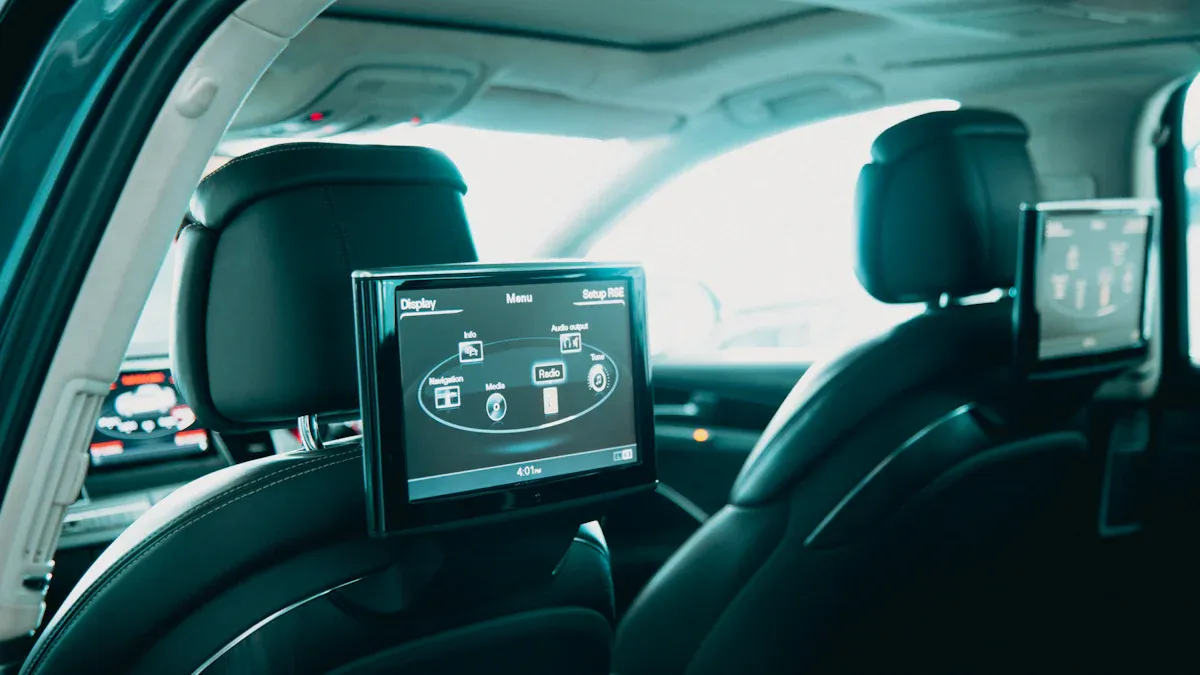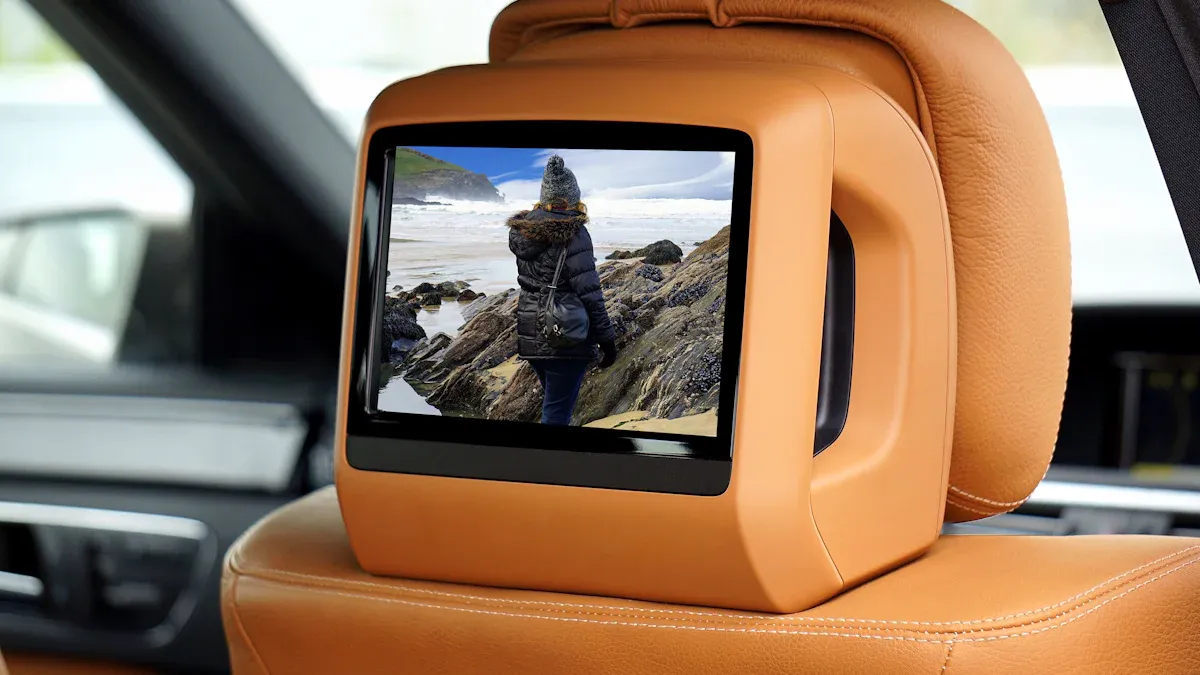
Rear seat advertising solutions use digital screens or tablets in cars. These screens show rear seat ads to people sitting in the back. Taxis, rideshare, and hired cars often have these systems. Passengers see rear seat ads as part of rear seat entertainment. This makes their trips more fun. More people want rear seat entertainment because they spend more time in cars. Rear seat ads help brands and also make rides more entertaining. The global rear seat entertainment market is growing by 12.5% each year. This growth is because of new technology and longer trips. Backseat advertising is now important for both ads and entertainment in ride-share cars.
Key Takeaways
Rear seat advertising puts digital screens in cars. These screens show ads and fun things to people in the back seat. This makes rides more fun and interesting. – The ads use data and real-time updates. They show content that matches what each person likes and where they are. – Drivers can make extra money by showing ads. They do not need to do any extra work. Passengers can play games, watch videos, and see local deals during their ride. – Advertisers can reach people who pay close attention. This helps people remember brands better. They can also change ads quickly to get better results. – Rear seat ads help local businesses. They are good for the environment because they use less paper. The digital screens also save energy.
Rear Seat Advertising Solutions

Overview
Rear seat advertising solutions put digital screens or tablets in car back seats. These screens show rear seat ads to people riding in the back. Companies use these in taxis, rideshare, and hired cars. The main goal is to get the attention of back seat passengers.
The technology for rear seat advertising solutions has improved fast. Old systems only played simple videos or pictures. Now, these platforms have interactive video, display ads, branded games, and surveys. Passengers can play games, answer polls, or watch special content. The system makes sure every ad is watched from start to finish. This helps brands see how well their ads do.
Modern rear seat ads use data to reach certain groups. For example, business people, tech fans, and travelers see ads that fit their likes. The system uses mobile data to send the right message to each person. This helps brands get noticed and get more clicks.
Note: Rear seat advertising solutions also help drivers make extra money. Many rideshare drivers get a share of the ad money. This makes these systems popular in ride-sharing cars.
Types
Rear seat ads show up in different kinds of vehicles. Each type uses its own way to show in-car ads:
Taxis: Regular taxis often have TV-like screens. These screens play news, weather, and backseat advertising. Passengers can mute or turn off the screen if they want. The ads in taxis are usually the same for every rider and do not change based on who is in the car.
Rideshare Vehicles: Rideshare companies like Uber and Lyft use tablets on the back of front seats. These tablets show rear seat ads that change by the passenger’s age, trip reason, or profile. Some systems, like Vugo, let passengers pick what they want to watch. This makes the ride more fun and personal. Rideshare ads often have real-time deals and local offers to get more people interested.
Hired Cars: Hired cars, like those for premium rideshare or private car services, sometimes use advanced infotainment systems. These systems can stream TV, movies, or live events. They also show rear seat ads mixed with entertainment. The ads may target high-value customers who use ride-hailing for business or luxury trips.
Rear seat advertising solutions use two main platforms:
Infotainment Systems: These systems started as simple DVD players but are now much more advanced. They support streaming, voice control, touchscreens, and even work tools. Infotainment systems connect to the cloud and use fast networks like LTE or 5G. This lets them show high-quality video and interactive content. Passengers can browse the web, watch TV, or use apps while seeing targeted rear seat ads.
Digital Out-of-Home (DOOH) Platforms: DOOH platforms use digital screens to show ads in public places, including cars. In ride-hailing, DOOH platforms show rear seat ads based on passenger data and trip info. These platforms track how many people watch or click on an ad. They help advertisers reach people who use ride-sharing and spend time on the road.
Rear seat advertising solutions keep growing as more people use ride-hailing. The mix of entertainment, interactivity, and targeted ads makes these systems useful for passengers, drivers, and advertisers.
How They Work

Technology
Rear seat advertising solutions use special hardware and software to get people’s attention. Most systems have LCD screens or tablets on the back of the front seats. These screens show ads, games, and fun things during every ride. Companies like Vugo and IVEE are leaders in using these screens with car infotainment systems.
Vugo links its TripIntent AI Platform and Content Management System to the car’s display. The TripIntent AI Engine collects trip data from many places. It uses this data to send ads and content right to the screen. The CMS picks what passengers see and when ads show up. This helps brands reach the right people at the best time. Vugo also lets big groups of cars use the system easily. The company gives hardware, software, and help to keep things working well.
IVEE does things a bit differently. It gives a 10-inch tablet that goes on the headrest. This system works in rideshare cars and does not need to connect to the car’s own system. IVEE’s tablet has streaming video, music, games, and interactive things. Passengers use touch or voice to use the screen. Ads show up with the fun stuff but do not stop the passenger’s experience. IVEE’s ads fit in with the content, so people keep watching.
Ad Delivery
Ad delivery in rear seat advertising uses real-time tech to reach people with the right message. LCD screens and tablets in ride-hailing cars show changing ads to people in the back. These ads can change by where you are, the time, or what you like. Advertisers use data to see how ads do and change them fast.
For example, United Airlines uses a media network to show real-time ads on seat-back screens during flights. This system uses travel data to show ads that fit each person, but it does not use personal info. Brands reach people with the right ads during the trip. The system updates ads in real time, so each message fits the people watching.
Rear seat ad platforms also let advertisers manage content from far away. They can update and plan ads from anywhere. This makes it easy to keep ads new and interesting. Showing ads in real time helps brands get people’s attention and get better results.
Tip: Tablet ads work well because people in the back seat cannot look away. This makes every ride a good time for brands to connect with people.
Targeting
Targeting is very important for these ads. Rear seat ad platforms use data to make ads more interesting. Advertisers can pick who sees ads by age, location, and ride details. Devices collect info about who is riding and what they might like. This helps show ads that fit each person.
Advertisers can also help local shops by showing ads for places nearby. This helps passengers feel closer to the community. Remote content management lets advertisers change ads fast, so they always fit the people in the car.
Platforms like Play Octopus and PaidAds work with ride-hailing services like Uber and Lyft. These systems use ride info, like where you get in and out, to show the right ads. Fun things like games and QR codes make people want to join in. Drivers get extra money, and advertisers reach people who pay attention.
Using data and real-time updates makes rear seat ads work better. Advertisers watch how ads do and change them if needed. This stops wasted ads and helps brands get more for their money. By showing ads to the right people at the right time, brands get noticed and keep people interested during the ride.
Note: Rear seat ad platforms let advertisers make special ads for certain groups, places, and times. This makes sure every ad gets to the right people and keeps them watching.
Benefits of Rear Seat Ads
Passengers
Rear seat ads make rides more fun for passengers. The screens show movies, music, and games. This turns travel time into something enjoyable. Many people say the ads grab their attention and make trips feel shorter. These ads give special content based on where and when you ride. This makes every trip feel different. Passengers remember these ads longer than billboards. People in the back seat pay more attention to the screens. Real-time updates and games keep riders interested. The system also gives helpful info, like local deals or coupons for stores nearby. This adds extra value to each ride.
Passengers get cool content that makes waiting feel shorter. Personalized ads and fun choices help make the trip special and interactive.
Drivers
Drivers earn more money from rear seat ads. Showing ads on screens helps drivers get paid extra. They do not need to do more work. People in the back seat watch the ads closely. This means more people notice and act on the ads. Drivers get this extra money along with their normal pay. Working with advertisers helps drivers and makes brands more popular. Drivers also get happier riders. Fun ads and entertainment can lead to better tips and ratings.
Advertisers
Advertisers reach people who pay close attention during rides. Rear seat ads let brands send messages to people who are really watching. This helps more people remember the brand. The system tracks how many people see and click on ads. Advertisers can change their ads quickly to get better results. Brands use things like QR codes or coupons to get people to act right away. The car is a special place, so ads stand out and are easy to remember.
Local Businesses
Local businesses reach people in their area with rear seat ads. People riding in cars see bright, moving ads that show off local brands. Businesses can make ads that fit local interests and places. Data shows how many people see, click, or use a coupon. This helps businesses change ads fast if needed. Rear seat ads are a cheap way to get more customers and sell more. They work well for reaching people in a certain area.
Features and Customization
Content Types
Rear seat entertainment platforms give many kinds of content to keep people interested. Screens in Uber cars show ads made just for each rider and special content. These systems use things like where you are going, what you bought before, and if you like a brand to pick what shows up. Passengers see ads from TV campaigns, local deals, and coupons for places to eat nearby. This helps brands talk right to each person in the car. Riders can watch short videos, listen to music, play games, or get news. By mixing fun things with ads, these platforms help brands get noticed and make rides better.
Interactivity
Interactive features help make rear seat entertainment more fun. Some ads let you tap on product cards or swipe to see more. This makes more people think about the brand and sign up for things. Touch screens and QR codes let riders get more info or use a coupon right away. Fun things in the app, like polls or shopping games, let people join in. Passengers can look at products, answer questions, or play games. Doing these things helps people remember the brand better. Ads can also change by where the car is, so they fit the place you are in.
Interactive in-app experiences turn watching into doing, which helps brands get noticed and makes rides more fun.
Personalization
Personalization is very important for rear seat advertising solutions. Advertisers use AI to group people and show ads that match what they like. The system uses where the car is to show ads that fit that spot. The platform can change what it shows based on who is riding, like business people or families. One system can work for many kinds of cars, so ads get to the right people. Personalization makes people pay more attention and enjoy the app more. Passengers get content that feels special, and brands get better results from their ads.
Cost and Environmental Impact
Value
Rear seat advertising platforms give special value to advertisers. These systems put digital screens in cars to reach people on trips. Advertisers pay about $300 to $400 per car for four weeks. This is more expensive than most taxi ads. The higher price is because rideshare ads are seen as premium. These ads reach people who sit in the back and watch the screens. Advertisers pay more to show ads to people who really pay attention.
Many brands get good results because riders look at the ads. Advertisers can change ads fast to match local events or deals. This makes the ads even more useful.
Here is a table that shows the usual costs:
Platform Type | Average Cost (4 Weeks) | Audience Reach |
|---|---|---|
Rideshare Interior | $300–$400 per car | High (captive) |
Traditional Taxi Ads | Lower | Moderate |
Sustainability
Rear seat advertising solutions also affect the environment. Digital screens in cars and planes add weight and use energy. This can make cars and planes use more fuel and create more pollution. Some companies, like Safran Passenger Innovations, make lighter and better screens. Lighter screens use less power and help save fuel. This helps the aviation industry lower its carbon footprint.
Many companies now use digital ads instead of paper flyers or billboards. This change means less paper is used and less trash is made. Digital ads help make advertising greener. By using fewer printed ads, companies show they care about the planet.
Rear seat advertising helps the environment by using less paper and saving energy. These changes make ads better for the earth and still reach people in cars.
Rear seat ads help passengers, drivers, and advertisers in many ways. Passengers like rides more when ads are interesting and show local deals. Drivers make extra money because riders watch the screens more. Advertisers get better brand recall since people in the back seat pay close attention. The table below explains how rear seat ads change in-car advertising:
Aspect | Summary |
|---|---|
Captive Audience | Rear seat ads focus on passengers for longer attention. |
Enhanced Brand Visibility | Good screen spots help people remember brands. |
Targeted Advertising | Ads fit where you are and who you are for better results. |
Cost-Effectiveness | Rear seat ads give cheap, trackable ad campaigns. |
Eco-Friendly Practices | Digital screens use less paper and help the planet. |
Support for Local Businesses | Local ads help shops find customers nearby. |
Future Outlook | Rear seat ads will change in-car ads and build strong connections. |
A new report says rear seat ads will keep growing as tech gets better and more people use rideshares. Companies need to fix problems like high costs, privacy, and fast tech changes. Rear seat ads will still grab attention and change how brands talk to riders.
FAQ
What types of ads appear on rear seat screens?
Passengers watch video ads and play games. They also see local deals and branded content. Some screens show news or weather updates. Advertisers pick content that matches the people and place.
How do rear seat ads target specific passengers?
Rear seat ad platforms use trip data and location. They also use rider profiles to choose ads. The system looks at age, where you are going, and what you like. This helps brands show ads to the right people.
Do rear seat ads affect driver earnings?
Drivers can make more money from rear seat ads. Many platforms give drivers a share of ad money. This extra pay adds to what drivers already earn. Drivers do not have to do extra work.
Are rear seat advertising solutions secure and private?
Most platforms keep passenger data safe. They use encryption and follow privacy rules. Personal info is protected, and advertisers only see general trends, not private details.
See Also
Understanding How Wireless CarPlay Adapters Enhance Your Driving
A Guide For Audi Owners Selecting The Best Android Auto Adapter
Comparing Wireless CarPlay Adapters And AI Boxes For Best Value
Top Wireless CarPlay Options Specifically For Toyota RAV4 Owners
Leading Wireless CarPlay Adapters To Ensure Smooth Driving Experience
